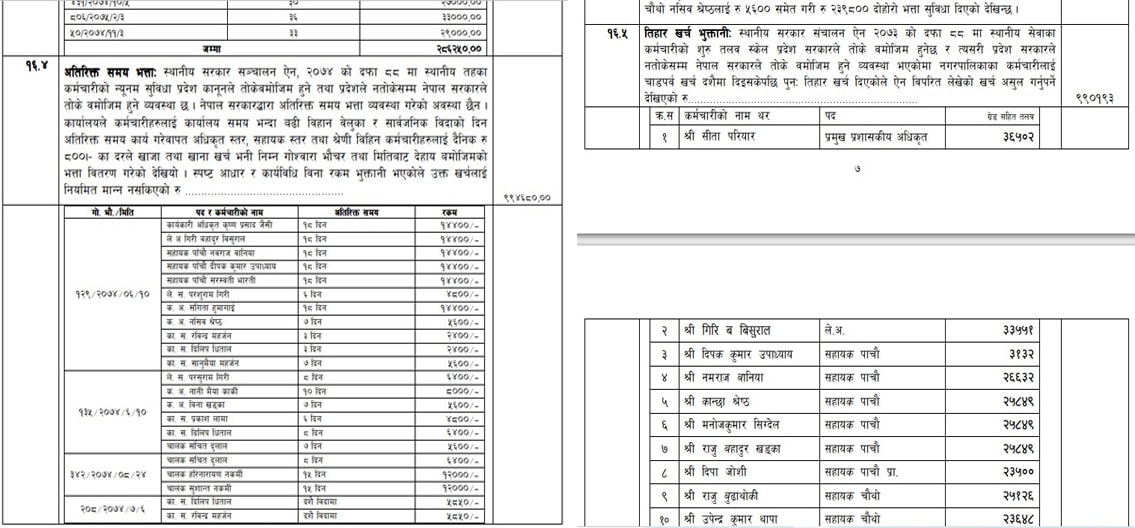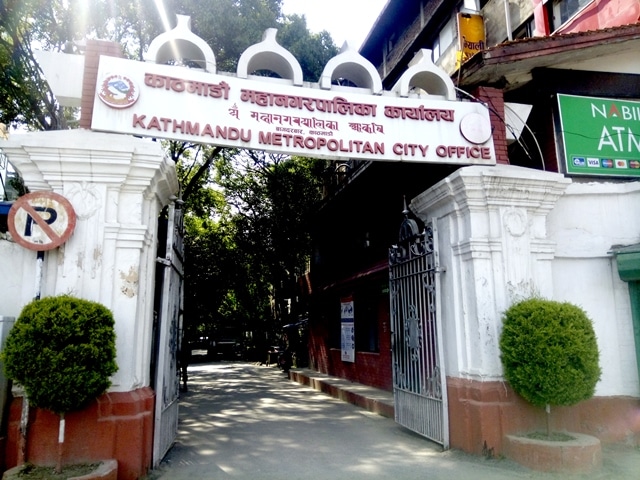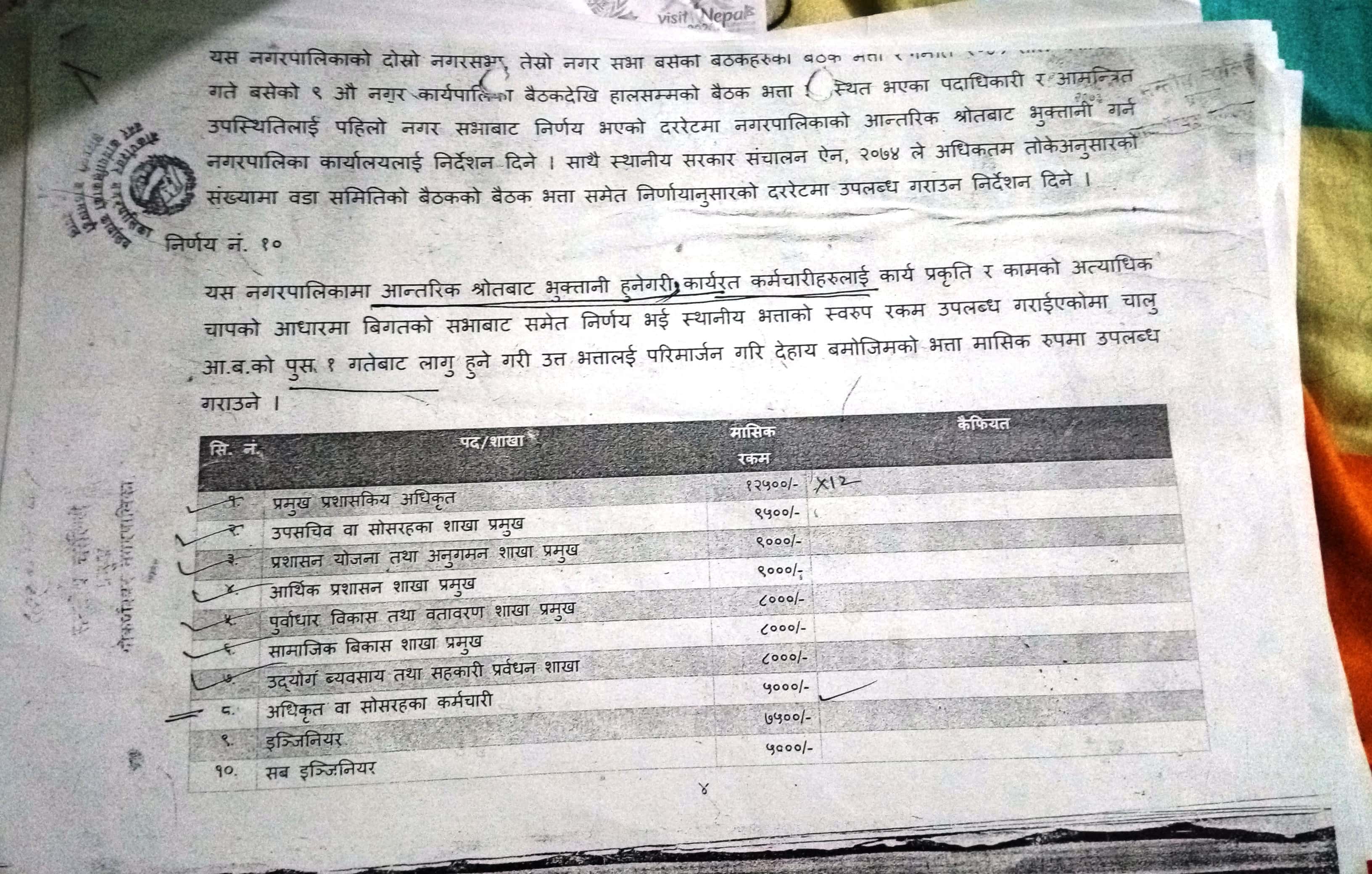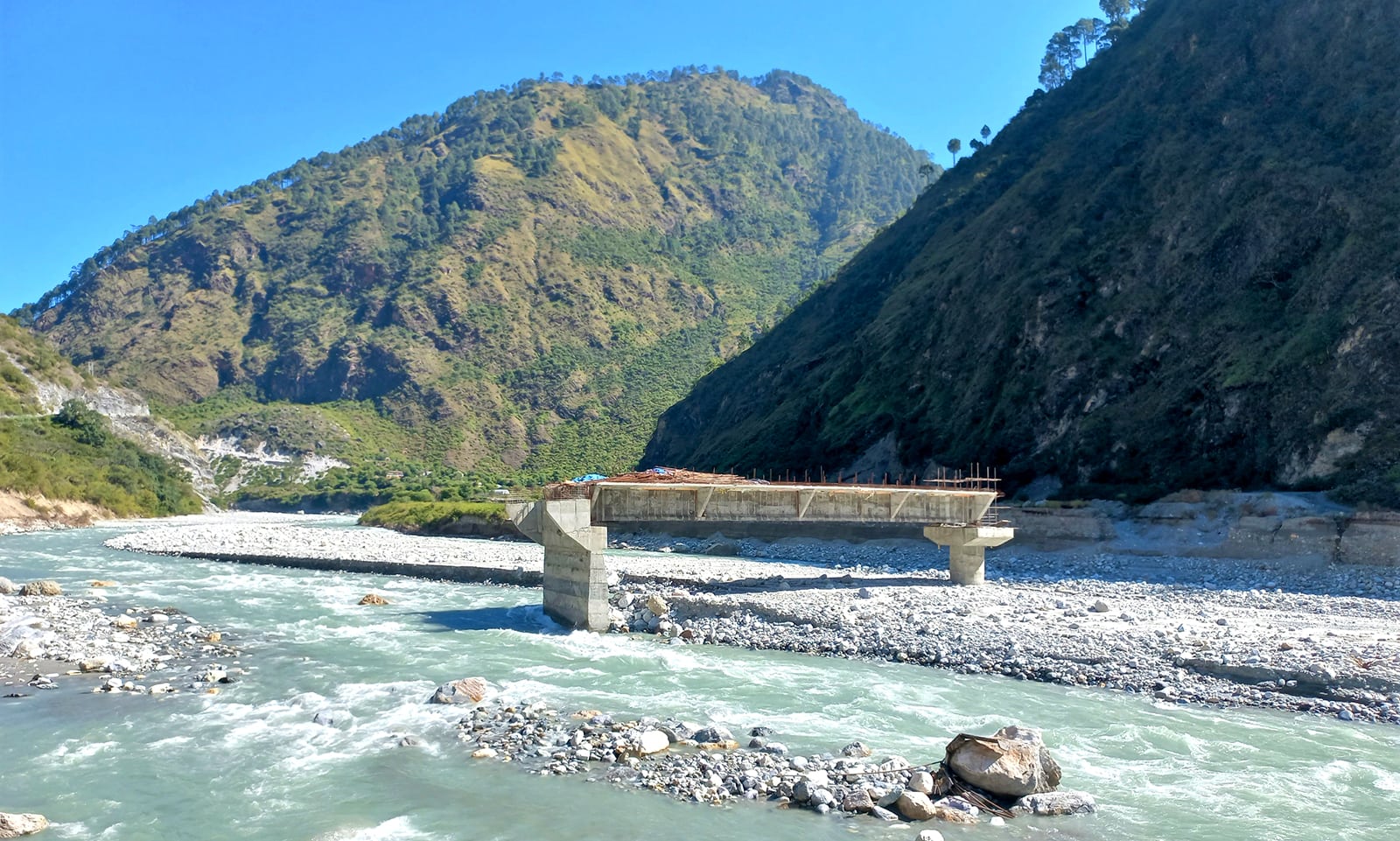The civil servants who got one level of promotion additional grades during adjustment have influenced the people’s representatives and received an additional Rs 5 billion and other facilities in the last three years.
Himal Lamsal: Centre for Investigative Journalism-Nepal
The Birgunj Metropolitan City in the fiscal year 2017/18 decided to pay an extra month of salary to civil servants during Tihar. It cost the metropolitan city an additional Rs 9.52 million. For the following fiscal year (2018/19) too, the civil servants received allowances for Tihar. This was in addition to the Dashain allowance worth one month of salary the bureaucrats are entitled to receive each year.
Sukadev Khatri Bhattarai, former acting auditor general, said there is a provision of taking back the money if the festival allowance is taken repeatedly.
Roop Narayan Raut, the finance officer at the metropolitan city, said the City Council had decided to distribute the allowance for Dashain and Tihar to the civil servants for two fiscal years. “When the Auditor General’s Office’s 56th report said it was a wrong practice, we cancelled the Tihar allowance altogether and started providing 10 percent of the monthly salary as local allowance instead,” Raut told CIJ Nepal.

Source: Office of the Auditor General annual report 2017/18, Chandragiri Municipality.
The metropolitan city has started providing allowances at a rate of 10 percent of the 12-month salary. Bijay Kumar Sarawagi, mayor of the metropolitan city, said the festival allowance was being provided even before he was elected as a mayor. “Before the employee adjustment, it was said that the salary they had been receiving wouldn’t be reduced. So we provided Tihar allowance for two years. But since the employee adjustment has been completed, we have stopped providing the allowance now,” Sarawagi said.
The employees of the Chandragiri Municipality also received double festival allowances after getting a decision passed by the city council. In the fiscal year 2017/18, a total of 51 employees of the metropolitan city received Tihar allowances worth Rs 9.90 lakh. In the fiscal year 2017/18, the metropolitan city had provided a total of Rs 5.18 million to its employees and people’s representatives as meeting allowances.
In the fiscal year 2017/18, a total of 51 employees received special allowances ranging from 10 to 60 percent of their salaries for overtime work as per the Employment Administration Regulation, 2071. A total of Rs 3.10 million was spent towards the allowances.
Sim card and recharge card expenses
The then chief administrative officers of the Chandragiri Municipality had received Rs 1.8 lakh for house rent at the rate of Rs 15,000 per month, in the fiscal year 2017/18. During that time, Krishna Prasad Jaisi and Sita Pariyar were working as chief administrative officers at the municipality. Jaisi worked from June 6, 2016 to October 8, 2017, and Pariyar from October 9, 2017 to August 16, 2018.
The municipality in the fiscal year 2018/19, until the middle of June, provided Rs 1.73 million as meeting allowances to employees. Similarly, it spent Rs 5.61 million on employee encouragement, Rs 1.10 million on inflation allowance and Rs 9.23 lakh on miscellaneous allowances.
The municipality in the fiscal year 2019/20 allocated Rs 1.5 million for employees’ meeting allowance, Rs 15 million for employee encouragement and prize, Rs 2 million for miscellaneous allowances, and Rs 3.3 million for inflation allowance.
The Office of the Auditor General has asked the municipality to return the amount so spent, calling it unlawful. But the municipality is yet to return the money. Conversely, Ghanashyam Giri, the mayor of the municipality, said imposing curbs on the facilities the employees have been receiving will hamper the work of the municipality. “Since the work is going to be hampered if we stop the salary and benefits, we haven’t stopped it immediately. In the coming days, the municipality will make a procedure and control it.”

Kathmandu Metropolitican City’s main entrance in Baghdurbar, Kathmandu.
The Kathmandu Metropolitan City has provided similar benefits to the employees who work from the office and those who put their lives at risk as frontline workers. The employees of the municipality receive almost 50 percent of their monthly salary by getting their attendance marked digitally. To receive additional allowances, the employees of the metropolitan city reach their offices at eight in the morning just to get a digital attendance done. “A culture has emerged whereby the employees come to the office at eight and go home for lunch at ten. But the metropolitan city is quiet on this.”
Buddha Ratna Manandhar, chief of the metropolitan city’s Finance Division, said the employees had been taking up to an additional 50 percent of the salary on the basis of their work during extra time. “We don’t look at the attendance of those who work as cleaning staff. But the office gives payment to those who work at the office on the basis of their attendance and when the administrative head recommends it.”
In the fiscal year 2017/18, the metropolitan city provided Rs 8.43 million, equivalent to two months of salary to the sanitation workers and office workers in the form of incentives and miscellaneous allowances. Similarly, it provided an additional Rs 5 lakh for Dashain-Tihar special sanitation and food that fiscal year.
On top of this, all the employees of the metropolitan city have been receiving an additional Rs 1,500 per month for the metropolitan allowance. According to the financial department of the metropolitan city, a sweeper gets an additional salary of three months annually. Garbage drivers and cleaners receive an additional 50 percent of their monthly salary apart from an extra month of salary. Hari Kumar Shrestha, the head of the environment department, said, “It is small compared to other countries.”
In the fiscal year 2017/18, the employees of Kathmandu Metropolitan City received a sum of Rs 72.2 million as additional allowances and facilities apart from regular salary. Similarly, until mid-July, the end of the fiscal year 2075/76, the metropolitan city distributed a total sum of Rs 1.8 billion for additional allowances and facilities to the staff. For the current fiscal year 2019/20, the metropolitan city has allocated Rs 257 million for allowances for employees.
From the fiscal year 2017/18 B.S, The Lalitpur metropolitan city has been providing transportation, lunch and other allowances to its employees. It has paid Rs 76.46 million to the sanitation workers in 2017/18 under these headings. Lalitpur has provided an additional allowance of Rs 57.33 million to the employees working in various branches for overtime duty.
Likewise, Rs 8.964 million was provided for additional food, ration and transportation expenses. Apart from this, Rs 3.6 lakh was provided to the employees as communication allowances. Lalitpur spent Rs 20.41 million in the fiscal year 2017/18 under the various heading towards providing better amenities for the employees.
Lalitpur spent a total of Rs 57.7 million in the fiscal year 2018/19, including Rs 34 million on staff meal and inflation allowance, Rs 11.5 million on meeting allowance and Rs 10.57 million on other allowances. For the current fiscal year, it has allocated Rs 43.8 million for staff lunch and inflation allowance and Rs 7.5 million for staff incentive expenses. According to the 2074/75 report of the Office of the Auditor General, 14 employees, including Suman Kumar Karki, the then chief administrative officer of Kirtipur Municipality, were provided with Rs 1.69 lakh against the Travel Expenses Rule, 2064 for field visit in 2074 B.S. They have taken this amount as field monitoring allowance.
Rule 7 (8) of the Travel Expenses Rules 2064 has a provision that daily allowance can’t be paid within 15 kilometers from the place of duty even if the employees spend the night in Kathmandu valley or any district. However, 14 employees, including CAO Karki, took field allowance in Kirtipur. The 2074/75 report of the Auditor General’s Office says that employees including the CAO should monitor and provide the basis for providing the allowance within the municipality or return the money. The voucher 24-064-6-10 of the municipality shows that CAO Karki received an allowance of 18,000 rupees.

Source: Gokarneshwor Municipality
Kirtipur spent Rs 41.96 million on staff allowances and facilities under various headings in the fiscal year 2018/19. In the fiscal year 2075/76, the municipality has spent a collective sum of Rs 7.2 million on staff facilities. In the fiscal year 2019/20, it allocated Rs 18 million. The Tokha Municipality distributed Rs 1.489 million local allowance to some employees, with the allowance amounts ranging from Rs 1,000 to seventeen thousand rupees. Some of the Tokha employees took an allowance of Rs 3.28 lakh from the Municipal Council in the fiscal year 2017/18 for overtime work ranging from 10 days to one month.
So much so that an allowance of Rs 7.10 lakh was distributed as meeting expenses of the Law Drafting Committee. In the fiscal year 2018/19, the municipality provided Rs 5 lakh as staff meeting allowance and Rs 2 lakh as monitoring allowance to the people’s representatives and employees. Similarly, Rs 2.52 lakh was distributed for field allowance and Rs 8.22 lakh for inflation allowance. As of April/May in the fiscal year 2076/77, Rs 6 lakh was spent on staff meeting allowance and Rs 22 lakh on employees’ inflation allowance. The Shankharapur Municipality in the fiscal year 2017/18 decided to give Rs 13,000 monthly allowance to the CAO, Rs 11,000 monthly to the accounts officer and Rs 5,000 monthly allowance to each ward secretary.
As per the decision, administrative officer Pramod Sinkhada received 1.43 lakh at the rate of Rs 13,000 per month for 11 months. Another administrative officer Durganath Gautam (transferred) received Rs 13,000 for a month. Accounts officer Kapil Prasad Adhikari received Rs 1.32 lakh for 12 months as allowance. In this way, everyone including seven ward secretaries got a total allowance of Rs 7.9 lakh for 12 months. Shankharapur decided to provide an additional allowance equal to one month’s salary, amounting to Rs 4.19 lakh, to the employees of the Municipal Council in the policy and program of the Fiscal Year 2074 BS.
Mayor Subarna Shrestha said the allowances had been provided to limited employees for encouragement. He said, “Additional allowances were provided to only those who were assigned to prepare the budget. But those who did not get the allowances protested, and everyone was given one month’s salary as incentive.” Similarly, in Shankharapur, in the fiscal year 2018/19, the employees received an encouragement allowance of Rs 6 lakh and an additional allowance of Rs 1.1 million for planning the budget. The municipality gave another Rs 5.25 lakh to the employees that year in the name of monitoring.
Seven meetings held to take allowance
The education branch of Tarakeshwor Municipality distributed seven meeting allowances after holding seven meetings on issues that can be decided in just one sitting. It was found out that nine employees were paid Rs 94,500 at the rate of Rs 1,500 per seven meetings from December 19 to 26, 2017 on the issue of conducting basic education examination. The 56th report of the Auditor General says it is illegal to take allowance after holding seven meetings on the same issue. In order to benefit the employees, Tarakeshwar had decided to give Rs 12,000 per month to the CAO, Rs 10,000 per month to the AO and incentive allowance to the other employees from the fiscal year 2017/18 B.S. It was issued on 18 September, 2017.
No procedure or criteria had been formulated for the same. Employees received an allowance of Rs 3.9 million in the fiscal year 2017/18 B.S. In the same year, the people’s representatives and employees spent about Rs 1.3 million on meeting allowance and monitoring allowance.
Employees of Tarakeshwar received an additional allowance of Rs 5.4 million by mid-May of the current fiscal year. A total of Rs 11 million has been allocated to provide additional services to the employees in the current fiscal year.
The fourth Municipal Council of Budhanilkantha Municipality held on July 5, 2019 decided to give Rs 8,000 monthly allowance to the CAO, Rs 7,000 to the AO and Rs 3,000 to other employees. The allowance is said to be provided to all the employees to make them regular, honest and accountable in their work.
The permanent staff haven’t been promoted yet, but those who came in adjustment have been promoted one level and an additional Rs 1500 will be provided to the fourth and fifth level employees. Budhanilkantha distributed Rs 31.88 million meeting allowance to the people’s representatives and employees in 2017. An additional Rs 1.45 lakh was provided as overtime work allowance and Rs 2.55 lakh for monitoring allowance. In the current fiscal year, Rs 14.4 million was allocated for employees’ incentive allowance and awards. Similarly, Rs 3 lakh was allocated for staff meeting allowance, Rs 4.5 million for other allowances, Rs 2.3 million for dress allowance, and Rs 4.5 million for inflation allowance.
Similarly, on December 16, 2018, the Gokarneshwor Municipal Council decided to give a local allowance of Rs 12,500 per month to the CAO and to all those on the basis of level. Similarly, the mayor’s driver was given 75 percent of the salary (Rs 13,755) and the deputy mayor and CAO’s driver was given 35 percent of the salary as (Rs 6,419) monthly allowance. In the fiscal year 2018/19 B.S, it was decided to give Rs 6 million in additional allowance, Rs 1 million in meeting allowance and Rs 2 million in inflation allowance to the employees. According to Shankar Dhakal, accounts officer at the municipality, since there was more work in the local level, the allowances were provided by the decision of the Municipal Council.
‘This loot should stop’
In the last three fiscal years, local level employees have received Rs 5.20 billion from the state treasury in the name of additional allowances and facilities, apart from regular salary and facilities. According to the Office of the Auditor General, local level employees received Rs 368.3 million in the same year in the name of incentive in 2074 B.S. alone. Employees received a huge sum of Rs 1.61 billion for additional facilities in the fiscal year 2018/19 B.S. Out of this, employees spent Rs 392.2 million on other allowances, Rs 322.2 million on incentives and rewards, Rs 218 million on local allowances, Rs 277 million on inflation allowances, Rs 130 million on meetings, Rs 32.4 million on food, Rs 31.1 million on field allowance and Rs 24 million on medical treatment.
According to the Office of the Comptroller and Auditor General, out of the last three years, local level employees received excessive allowances and facilities in the current fiscal year. As of June 29, 2020, 723 local level employees received an additional allowance of Rs 3.22 billion. Out of this, Rs 483.33 million was spent on local allowances, Rs 956.1 million on inflation allowances, Rs 44.3 million on field allowances, Rs 200 million on staff meeting allowances and Rs 651.1 million on other allowances. Similarly, Rs 653 million was spent on dress allowances for employees, Rs 170 million on food allowances and Rs 55.4 million on medical treatment this year.
The fascination towards additional facilities is no less among people’s representatives. The local level people’s representatives received Rs 2.24 billion in the last three fiscal years in addition to their salaries. According to the 56th report of the Auditor General, the local level people’s representatives received Rs 733.5 million for services other than salary in the fiscal year 2017-18 and Rs 93.19 million in fiscal year 2018/19 B.S. The data of the Office of the Comptroller and Auditor General shows that the people’s representatives were paid Rs 533 million excluding salary till June 29 of the current fiscal year.
The people’s representatives had received Rs 474.50 million for meeting allowance and Rs 64.5 million for other allowances this year. Former finance secretary, Rameshwar Khanal says that taking additional allowances and services after receiving legal remuneration and facilities is an exploitation of the state. Khanal said, “If there is a moral culture, one cannot take double the benefit against the law. Ironically, a limited number of employees and people’s representatives have illegally ruled over the people’s taxes. All the facilities taken against the government’s policies should be recovered.”
Apart from the regular salaries available to the employees, a large amount of money has been provided to the local level employees in the name of additional allowance, local allowance, dress allowance, food allowance, medical treatment allowance, inflation allowance, field allowance, meeting allowance and incentive and reward allowance.
The 56th report of the Auditor General says that financial interests of the employees and the people’s representatives at the local level have reached the level of defaming the federal system of government. Former Acting Auditor General Sukdev Khatri Bhattarai said, “It is too late to stop all the allowances and facilities being distributed by the local, state and federal governments except the essential ones.”
In the first two years after the 2074 local elections, most of the local levels were run by very few staff. After the employees refused to go to the local level, the federal government issued the Employees Adjustment Act on February 22, 2019 and took a policy of automatically promoting one level and adding one grade when sending civil servants to the local levels and the provinces. However, the interest of the employees who have been adjusted at the local level with one level promotion and additional grade is on getting more allowances and facilities. Employees are intent upon getting additional services from the meeting of the Municipal Council and Executive Committee by negotiating with the people’s representatives. According to the Ministry of Federal Affairs and General Administration, 32,214 employees out of a total 43,614 at the local level have been adjusted so far.
At the meeting of the Council of Ministers on May 9, 2018, the federal, state and local governments had issued Policy Guidelines, 2075 to maintain economy and effectiveness in public expenditure. The guideline was issued to cut the facilities taken by the employees and people’s representatives. But there is a growing tendency to take advantage of the situation at the local level by making a mockery of it. Shyam Krishna Bhurtel, an expert on federal affairs, said, “The provincial government can get allowances and services only by making provisions of the municipality and city members as per the constitution. Otherwise they will not get it. The current mockery of the system must be stopped.”
The constitution has provided that the operation of rural assembly and municipal assembly, procedure of meeting, formation of the committee, vacancy of members, facilities available to members of village assembly and municipal assembly, and other arrangements related to village and municipal executive staff and office shall be in accordance with provincial law.
Article 88 of the Local Government Operation Act, 2074 BS specifies that the basic salary scale of local service employees shall be as specified by the central government unless specified by the provincial government. However, on the contrary, the employees have taken additional allowances and facilities by deciding on the local level. Deputy Auditor General Bishnu Prasad Rijal said the tendency of giving allowances and other facilities to the employees has increased exponentially due to the local levels making decisions on their own. “It has been found that the local levels have decided to provide services on their whims rather than in accordance with the law,” Rijal said.



